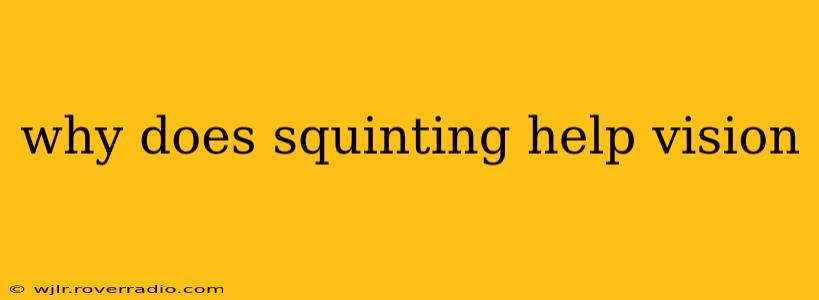Squinting, that involuntary (or sometimes voluntary) narrowing of the eyes, might seem like a simple act, but it actually has a significant impact on how we see. While it's not a solution for correcting vision problems, understanding why squinting improves clarity can offer valuable insights into our visual system. This post will delve into the science behind this common behavior, answering your questions about its effectiveness and limitations.
How Does Squinting Improve Vision?
Squinting helps improve vision primarily by reducing the amount of light entering the eye and increasing the depth of field. Let's break that down:
-
Reduced Light Scatter: When light enters the eye, it can scatter within the cornea and lens. This scattering blurs the image, especially in individuals with refractive errors like myopia (nearsightedness) or hyperopia (farsightedness). Squinting effectively reduces the size of the pupil, the opening in the iris that controls the amount of light entering the eye. A smaller pupil means less light scatter, resulting in a sharper, clearer image. Think of it like adjusting the aperture on a camera lens – a smaller aperture creates a sharper image with increased depth of field.
-
Increased Depth of Field: Depth of field refers to the range of distances within which objects appear acceptably sharp in an image. Squinting effectively increases this depth of field. By reducing the size of the pupil, it narrows the cone of light entering the eye, improving focus across a wider range of distances. This is particularly helpful for individuals with astigmatism, a condition where the cornea or lens is irregularly shaped, leading to blurry vision at various distances.
-
Blocking Peripheral Light: Squinting can also block peripheral light that might be contributing to glare or blurry vision. This is especially beneficial in bright light conditions or when looking at objects against a bright background.
Why Doesn't Squinting Correct Vision Problems?
While squinting provides temporary visual improvement, it's crucial to understand that it doesn't actually correct any underlying vision problems. It's merely a workaround, a way to compensate for imperfections in the eye's focusing mechanism. Continuing to squint frequently can lead to:
-
Eye Strain and Headaches: Constantly contracting the eye muscles to squint can cause fatigue, strain, and headaches.
-
Eyestrain: The muscles controlling the eye may become tired leading to discomfort and blurry vision, even when not squinting.
-
Wrinkles: The repetitive action of squinting can contribute to the formation of wrinkles around the eyes.
What Should I Do If I Need to Squint to See Clearly?
If you find yourself frequently squinting to see clearly, it's essential to consult an ophthalmologist or optometrist. They can perform a comprehensive eye exam to determine the underlying cause of your blurry vision and recommend appropriate corrective measures, such as eyeglasses, contact lenses, or other vision correction treatments. Ignoring the need for corrective lenses can lead to further vision problems and eye strain in the long run.
What are the causes of blurry vision that might require squinting?
Blurry vision, often necessitating squinting, can stem from several causes, including:
-
Refractive errors: Myopia (nearsightedness), hyperopia (farsightedness), and astigmatism are common refractive errors affecting the way light focuses on the retina.
-
Eye conditions: Certain eye conditions like cataracts (clouding of the eye's lens), macular degeneration (damage to the central part of the retina), and glaucoma (damage to the optic nerve) can impair vision.
-
Other health issues: Systemic diseases such as diabetes, multiple sclerosis, and hypertension can also manifest as blurry vision.
-
Medications: Side effects from certain medications can impact vision clarity.
How can I prevent eye strain from squinting?
Preventing eye strain associated with squinting involves addressing the underlying cause: getting your vision checked and corrected. But beyond that, here are some tips:
-
Proper lighting: Ensure adequate lighting when reading or working on close-up tasks.
-
Regular breaks: Take frequent breaks when performing visually demanding tasks to rest your eyes.
-
20-20-20 rule: Every 20 minutes, look at an object 20 feet away for 20 seconds.
-
Healthy diet: A balanced diet rich in antioxidants and omega-3 fatty acids can support eye health.
In summary, while squinting offers a temporary solution to improve visual clarity by reducing light scatter and increasing depth of field, it's not a substitute for proper vision correction. If you frequently need to squint to see clearly, schedule an appointment with an eye care professional to determine the cause and receive appropriate treatment. Ignoring this could lead to further vision problems and discomfort.
